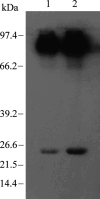Effective induction of antitumor immunity by immunization with plasmid DNA encoding TRP-2 plus neutralization of TGF-beta
- PMID: 15750831
- PMCID: PMC11032863
- DOI: 10.1007/s00262-004-0619-4
Effective induction of antitumor immunity by immunization with plasmid DNA encoding TRP-2 plus neutralization of TGF-beta
Abstract
Plasmid DNA vaccine is an appealing cancer immunotherapy. However, it is a weak immunogen and immunization with plasmid DNA encoding self-antigens, such as melanoma-associated antigens, could not induce antitumor immunity because of tolerance. In this study, we investigated the feasibility of using a plasmid DNA encoding Xenopus laevis transforming growth factor-beta 5 (aTGF-beta5) as an immunogen to induce neutralizing antibodies against murine TGF-beta1 (mTGF-beta1) and thus enhance the efficacy of plasmid DNA vaccine encoding murine tyrosinase-related protein 2 (mTRP-2) through neutralization of TGF-beta. The results showed that immunization with aTGF-beta5 resulted in the generation of mTGF-beta1-neutralizing antibodies, and immunization with a combination of aTGF-beta5 and mTRP-2 induced specific cytotoxic T lymphocytes (CTLs). On the contrary, immunization with mTRP-2 alone could not elicit the CTL response. Moreover, immunization of C57BL/6 wild-type mice with a combination of aTGF-beta5 and mTRP-2 induced the protective and therapeutic antitumor immunity to B16F10 melanoma, whereas the antitumor activity was abrogated in both CD4-deficient mice and CD8-deficient mice on the C57BL/6 background. Our results indicate that immunization with aTGF-beta5 is capable of breaking immune tolerance and induces mTGF-beta1-neutralizing antibodies. Neutralization of TGF-beta can enhance the efficacy of DNA vaccine encoding mTRP-2 and the induction of antitumor immunity by this immunization strategy is associated with CD4+ and CD8+ T cells.
Figures







Similar articles
-
New generation of DNA-based immunotherapy induces a potent immune response and increases the survival in different tumor models.J Immunother Cancer. 2021 Apr;9(4):e001243. doi: 10.1136/jitc-2020-001243. J Immunother Cancer. 2021. PMID: 33795383 Free PMC article.
-
Ubiquitin-fusion degradation pathway plays an indispensable role in naked DNA vaccination with a chimeric gene encoding a syngeneic cytotoxic T lymphocyte epitope of melanocyte and green fluorescent protein.Immunology. 2004 Aug;112(4):567-74. doi: 10.1111/j.1365-2567.2004.01916.x. Immunology. 2004. PMID: 15270727 Free PMC article.
-
Generation of antitumor immunity by cytotoxic T lymphocyte epitope peptide vaccination, CpG-oligodeoxynucleotide adjuvant, and CTLA-4 blockade.Cancer Res. 2003 Jun 15;63(12):3281-8. Cancer Res. 2003. PMID: 12810660
-
Genetic immunization of mice with human tyrosinase-related protein 2: implications for the immunotherapy of melanoma.Int J Cancer. 2000 Apr 1;86(1):89-94. doi: 10.1002/(sici)1097-0215(20000401)86:1<89::aid-ijc14>3.0.co;2-i. Int J Cancer. 2000. PMID: 10728600
-
Alternative roles for interferon-gamma in the immune response to DNA vaccines encoding related melanosomal antigens.Cancer Immun. 2001 Aug 16;1:9. Cancer Immun. 2001. PMID: 12747770
Cited by
-
Targeting TGF-β Signaling for Therapeutic Gain.Cold Spring Harb Perspect Biol. 2017 Oct 3;9(10):a022301. doi: 10.1101/cshperspect.a022301. Cold Spring Harb Perspect Biol. 2017. PMID: 28246179 Free PMC article. Review.
-
Systemic blockade of transforming growth factor-beta signaling augments the efficacy of immunogene therapy.Cancer Res. 2008 Dec 15;68(24):10247-56. doi: 10.1158/0008-5472.CAN-08-1494. Cancer Res. 2008. PMID: 19074893 Free PMC article.
References
-
- van der Bruggen P, Traversari C, Chomez P, Lurquin C, De Plaen E, Van den Eynde B, Knuth A, Boon T. A gene encoding an antigen recognized by cytolytic T lymphocytes on a human melanoma. Science. 1991;254:1643. - PubMed
-
- Rosenberg SA. Development of cancer immunotherapies based on identification of the genes encoding cancer regression antigens. J Natl Cancer Inst. 1996;88:1635. - PubMed
Publication types
MeSH terms
Substances
LinkOut - more resources
Full Text Sources
Research Materials

